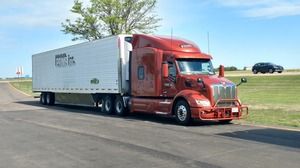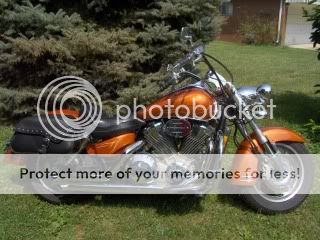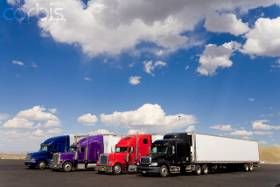Where To Set The Tandems ?
Topic 2294 | Page 2

When I was going through training, my trainer told me that a good place to set your tandums until you can get to a CAT scale , is to set the tandums under the rear of the load (or as close as you can). 9 times out of 10, that will be very close.
Ernie
CAT Scale:
A network of over 1,500 certified truck scales across the U.S. and Canada found primarily at truck stops. CAT scales are by far the most trustworthy scales out there.
In fact, CAT Scale offers an unconditional Guarantee:
“If you get an overweight fine from the state after our scale showed your legal, we will immediately check our scale. If our scale is wrong, we will reimburse you for the fine. If our scale is correct, a representative of CAT Scale Company will appear in court with the driver as a witness”

My company provided a sheet in our "Red Book" which is our Bible that lists all the trailers the company owns and how many holes from the front you slide the tandems to meet the California requirements, which are the most stringent. It also lists the requirements from every other state that requires them...some states have no requirement.
There are a few short cuts you can take....if you know how far the kingpin is back from the front of the trailer and how long the trailer is, you can measure from the BACK of the trailer. For instance, a 53' trailer with a 4' kingpin will require you to move the tandems so the back axle is 8' from the rear of the trailer. This can be a little dicey, because the back of the trailers are different lengths. Adding a few inches is a good idea if you aren't sure.
But whatever you do...be darn sure you meet the 40' requirement if you roll across a scale in California or you WILL get ticketed. If in doubt, measure it out. I carry a tape measure for this purpose.
Tandems:
Tandem Axles
A set of axles spaced close together, legally defined as more than 40 and less than 96 inches apart by the USDOT. Drivers tend to refer to the tandem axles on their trailer as just "tandems". You might hear a driver say, "I'm 400 pounds overweight on my tandems", referring to his trailer tandems, not his tractor tandems. Tractor tandems are generally just referred to as "drives" which is short for "drive axles".
Tandem:
Tandem Axles
A set of axles spaced close together, legally defined as more than 40 and less than 96 inches apart by the USDOT. Drivers tend to refer to the tandem axles on their trailer as just "tandems". You might hear a driver say, "I'm 400 pounds overweight on my tandems", referring to his trailer tandems, not his tractor tandems. Tractor tandems are generally just referred to as "drives" which is short for "drive axles".

I had to search quite a ways back to find this thread to refresh my memory on a few things so thought I would bump it up for some of the newer members to read. Some great suggestions here.
Woody

Speaking of setting tandems , another thing to consider is the sliding 5th wheel. When I was in one truck, I had to slide the 5th wheel forward, a little to keep the weight off my drive tires. Now with this truck, I have to slide the 5th wheel back to keep weight off my steer tires.
Dave
Tandems:
Tandem Axles
A set of axles spaced close together, legally defined as more than 40 and less than 96 inches apart by the USDOT. Drivers tend to refer to the tandem axles on their trailer as just "tandems". You might hear a driver say, "I'm 400 pounds overweight on my tandems", referring to his trailer tandems, not his tractor tandems. Tractor tandems are generally just referred to as "drives" which is short for "drive axles".
Tandem:
Tandem Axles
A set of axles spaced close together, legally defined as more than 40 and less than 96 inches apart by the USDOT. Drivers tend to refer to the tandem axles on their trailer as just "tandems". You might hear a driver say, "I'm 400 pounds overweight on my tandems", referring to his trailer tandems, not his tractor tandems. Tractor tandems are generally just referred to as "drives" which is short for "drive axles".

It will be different with every truck. I depends on the weight dispersal of the truck...where the fuel tanks are hung, forward/back, where the engine sits, over axle/back. length of cab+sleeper, and the overall length of the frame...so the variables are endless...you just learn with every truck you get into.....
Make sure if you have a truck with a weight gauge instead of the psi gauge you double check it with a scale. I have a 2012 International Prostar and it's nice it reads pounds, but I found it reads 2k light. I was sure glad I didn't learn the hard way.

Make sure if you have a truck with a weight gauge instead of the psi gauge you double check it with a scale. I have a 2012 International Prostar and it's nice it reads pounds, but I found it reads 2k light. I was sure glad I didn't learn the hard way.
Not all trucks have a Weight Gauge. My truck does not and I really do not need one. Matter of fact most company trucks do not have one.

My truck has a load gauge,and the trailers have the right weigh scaling system.some of the new trailers dont have a 41foot mark on the trailer.I find a like trailer,and measure panels,4th panel from rear,usually is right at 41 (center rivits of fourth panel)

I'm in a Volvo if that helps.
That's the problem ... say, you don't wear an Adidas track suit and drive with your feet on the dash do you? Are you Russian?? Just checking ... the Freightliner gauge usually reads in pounds so I don't know what Daniel was talking about (he IS Russian ... ) but if your's reads in psi then there is probably a conversion chart in your owner's manual ... if you are really worried about the load, most trailers in the 6th hole will be OK but head for a CAT scale ASAP and get the actual weight ... some trailers also have a built in scale under the rear tandems and while you are near the scales with the correct weight in hand (the report they give you) you can calibrate your gauges so they are more accurate later ... just takes a skinny bladed screwdriver and you use the adjustment screw on the face of the gauge to set the needle ...
Jopa

Tandems:
Tandem Axles
A set of axles spaced close together, legally defined as more than 40 and less than 96 inches apart by the USDOT. Drivers tend to refer to the tandem axles on their trailer as just "tandems". You might hear a driver say, "I'm 400 pounds overweight on my tandems", referring to his trailer tandems, not his tractor tandems. Tractor tandems are generally just referred to as "drives" which is short for "drive axles".
Tandem:
Tandem Axles
A set of axles spaced close together, legally defined as more than 40 and less than 96 inches apart by the USDOT. Drivers tend to refer to the tandem axles on their trailer as just "tandems". You might hear a driver say, "I'm 400 pounds overweight on my tandems", referring to his trailer tandems, not his tractor tandems. Tractor tandems are generally just referred to as "drives" which is short for "drive axles".
SAP:
Substance Abuse Professional
The Substance Abuse Professional (SAP) is a person who evaluates employees who have violated a DOT drug and alcohol program regulation and makes recommendations concerning education, treatment, follow-up testing, and aftercare.
CAT Scale:
A network of over 1,500 certified truck scales across the U.S. and Canada found primarily at truck stops. CAT scales are by far the most trustworthy scales out there.
In fact, CAT Scale offers an unconditional Guarantee:
“If you get an overweight fine from the state after our scale showed your legal, we will immediately check our scale. If our scale is wrong, we will reimburse you for the fine. If our scale is correct, a representative of CAT Scale Company will appear in court with the driver as a witness”
New Reply:
New! Check out our help videos for a better understanding of our forum features

















Preview:
This topic has the following tags:
Driver Responsibilities Safe Driving Tips







 TT On Facebook
TT On Facebook
If you just went to school but didn't company train yet you really wouldnt know this yet. Your trainer is the one that should provide real world training. Unfortunately ive only driven kws and freightshakers so I cant tell ya about a volvo but both of my trucks were between 50-60 onethe suspension gage.